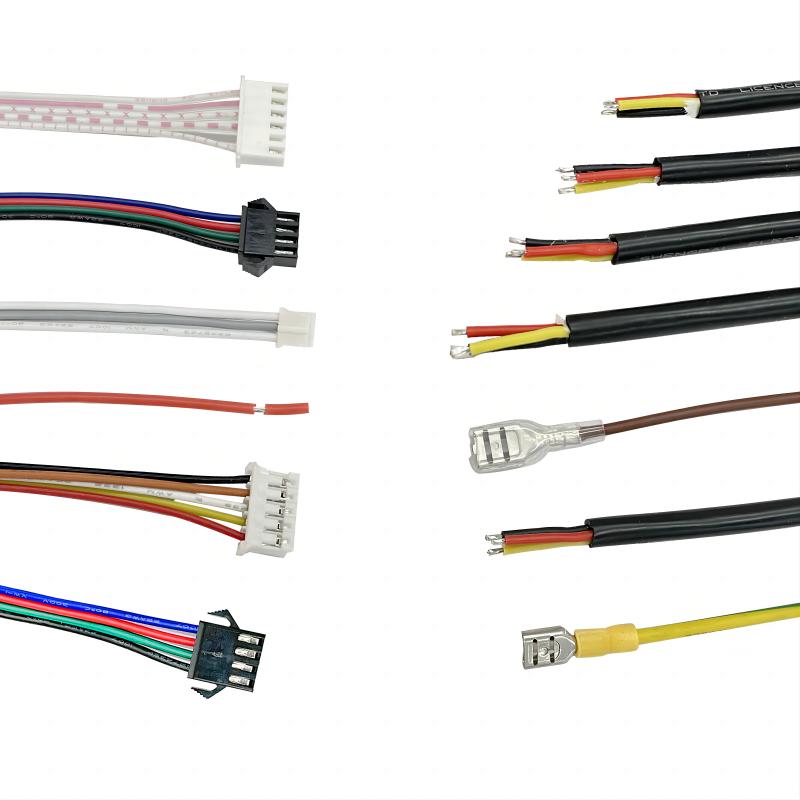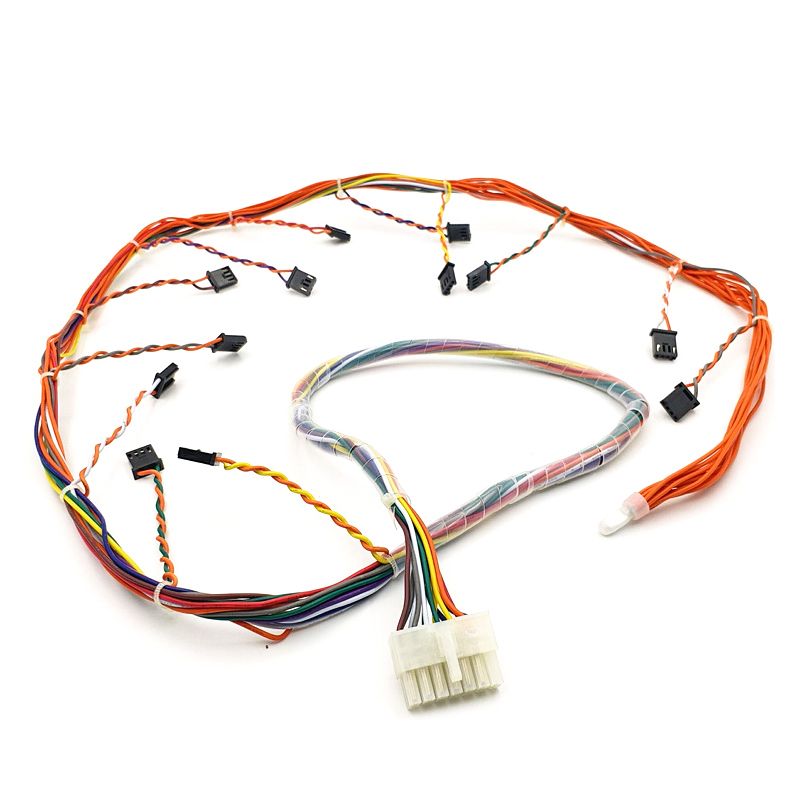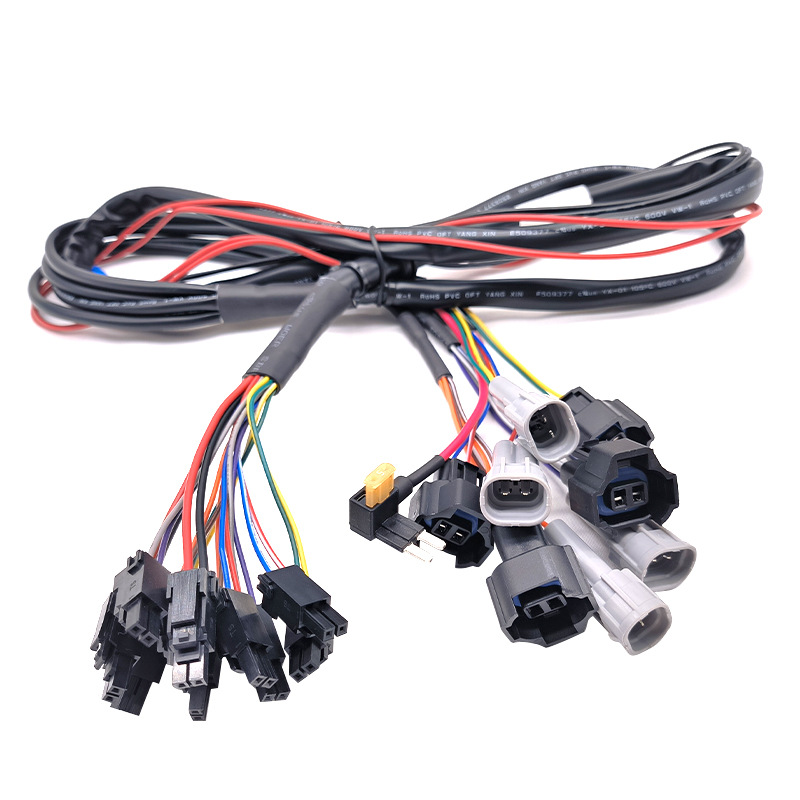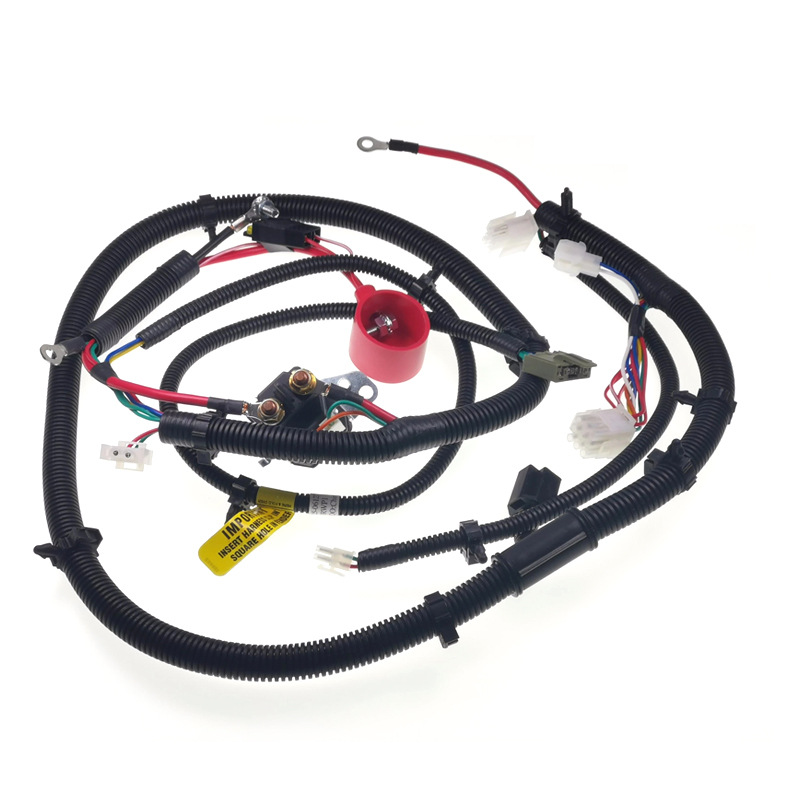What is the high voltage wire harness?
What is a high voltage wire harness cable assembly?
High voltage wiring harness cable assembly is an electrical connection device used to transmit electrical energy in high voltage power transmission and distribution systems. It consists of multiple insulated wires, usually made of pure copper or pure aluminum, and wrapped in insulating materials to prevent current leakage or short circuits. High voltage wire harnesses and cable assembly are widely used in fields such as power systems, electrical equipment, transportation vehicles, and industrial machinery.
Composition of high voltage wiring harness cable assembly
The high voltage wiring harness cable assembly is composed of wires, cables, insulation materials, sheaths, connectors, etc
1. Wire and cable:
The wires and cables of high voltage wire harnesses cable assembly are usually made of copper or aluminum materials, because these two materials have good conductivity and mechanical strength. The cross sectional shape of a wire and cable can be round, flat, or other special shapes, depending on the application requirements.
There are several ways to twist the cores of high voltage wire and cable conductors:
- Coaxial stranding: Coaxial stranding is a common method in which one or more insulated wires cables are wound around a central wire, forming a concentric circle. This method is used for some high frequency and RF applications, such as television antenna cables.
- Twisted pair: Twisted pair is a method of twisting two insulated copper or aluminum wires together. This stranding method is commonly used in data transmission cables such as computer networks (such as Ethernet) and telephone lines to reduce electromagnetic interference.
- Triple stranded wire: Triple stranded wire is a method of twisting three insulated wires together. This is typically used for power cables to provide higher current capacity and better anti interference performance.
- Quad wire: Quad wire is a method of twisting four insulated wires together. This method is usually used in communication cables such as Ethernet and telephone lines to provide higher data transmission speed and better anti interference performance.
- Five twisted wires: Five twisted wires are a method of twisting five insulated wires together. This is usually used for certain special applications, such as some high frequency and audio signal transmission cables
2. Insulation material:
Insulation material is a very important component in high voltage wiring harnesses and cable assembly, used to wrap wires to prevent current leakage or short circuits. Common insulation materials include polyvinyl chloride (PVC), cross linked polyethylene (XLPE), and propylene butadiene copolymer (ABS). Different insulation material has different characteristics, such as high temperature resistance, cold resistance, wear resistance, etc. Therefore, when selecting insulation materials, it is necessary to choose according to the specific application environment and requirements.
3. Sheath:
The sheath of high voltage wiring harnesses cable assembly is mainly used to protect the wiring harness from external environmental damage, such as moisture, chemicals, mechanical friction, etc. Common sheath materials include polyvinyl chloride (PVC), polyurethane (PU,PUR, TPU), polypropylene (PP), etc. Choosing the appropriate sheath material can improve the durability and reliability of the wiring harness
4. high voltage connectors:
connectors are the connection joints between high voltage wiring harnesses and electrical equipment or other wiring harnesses. There are various types of connectors, including plugs, sockets, terminals, etc. The quality and contact resistance of the connector have a significant impact on the transmission performance of the wiring harness. Therefore, when selecting the connector, it is necessary to consider its quality, durability, and adaptability
High voltage wire harness cable assembly application field
High voltage wire harnesses cable assembly are widely used in various fields, and the following are several common application areas:
1. Power system:
High voltage harnesses cable assembly are used in the power system to transmit and distribute electrical energy. They connect power equipment between power plants, substations, and users to ensure the safe and stable transmission of electricity.
2. Electrical equipment:
High voltage wiring harnesses cable assembly are widely used in various electrical equipment, such as televisions, computers, refrigerators, etc. They are used to transmit electrical energy and signals, Ensure the normal operation of the equipment
3. Transportation:
High voltage wiring harnesses cable assembly play a crucial role in vehicles such as cars, airplanes, and trains. They are used to transmit electrical energy and signals, driving various systems and equipment of vehicles.
Analysis of crimping performance of high voltage wire harness cable assembly terminals and connectors.
1. Electrical performance analysis:
Resistance test: Measure the resistance of the connection through resistance testing to ensure electrical continuity of the connection. The resistance should be within a certain range and not too high to avoid energy loss or heating.
Current capacity: Ensure that the connection can withstand the design current to prevent overload or current loss of control. This involves the conductivity of terminals, connectors and wiring harnesses and cable assembly.
Voltage insulation: Ensure that the connection will not experience breakdown or leakage under high voltage conditions, to prevent electrical faults or hazards.
Voltage reduction under high voltage: Evaluate the voltage reduction of the connection under high load to ensure that there is no significant voltage loss on the connection.
2. Mechanical performance analysis:
Connection firmness: Ensure that the connection between the terminals(connectors)and the wiring harness cable assembly is firm and will not loosen or break under vibration or impact conditions.
Mechanical strength of the connection: Consider the performance of the connection under tensile, shear, and bending stresses to ensure sufficient strength in the high voltage wiring harness and cable assembly.
Plug and unplug times: Evaluate the number of plug and unplug times of the connection, especially for applications that require frequent connection and disconnection, to ensure that the connection does not fail during the plug and unplug process.
3. Environmental resistance performance analysis:
Corrosion resistance: Evaluate the corrosion resistance of the connection under harsh environmental conditions to ensure that the connection is not damaged by chemicals or humidity.
High and low temperature resistance: For applications that require operation under extreme temperature conditions, ensure that the connection can withstand high and low temperature environments.
Dust and waterproof performance: Ensure reliable connection in the presence of dust, moisture, or other external substances.
4. Standards and Compliance:
Ensure that the connection complies with relevant industry standards and regulations, such as UL (Underwriters Laboratories), IEC (International Electrotechnical Commission), etc.
5. Inspection and Testing:
Use appropriate instruments and testing methods to inspect and test the connection to verify its performance.
6. Fault analysis:
Conduct fault analysis to determine the cause of connection failure, in order to improve the manufacturing process or select better materials and technologies.
Custom design of high voltage wiring harness cable assembly.
1. Determine requirements and specifications for high voltage wiring harness cable assembly.
- Firstly, clearly define the requirements for high voltage wiring harnesses cable assembly, including specifications for voltage, current, battery capacity, and other aspects. These specifications will determine the size and material selection of the wiring harness and cable assembly.
- It is also necessary to consider the layout, including battery position, motor position, charging interface, etc., to determine the length and path of the wiring harness and cable assembly.
2. Safety design for high voltage wiring harness cable assembly:
- High voltage wiring harnesses must have a high degree of safety to prevent risks such as electric shock and fire. Use insulating materials and coatings to wrap the wiring harness to reduce the risk of electric shock.
- Regularly conduct insulation and flame retardant tests to ensure the safety of the wiring harness.
3. Material selection for high voltage wiring harness cable assembly:
- Choose materials with high quality, high temperature resistance, and good insulation performance to ensure the reliability and durability of the wiring harness.
- Use components such as insulation sleeves, insulation tapes, and high temperature resistant connectors.
4. Harness path planning for high voltage wiring harness cable assembly:
- Determine the path of the wiring harness to minimize potential mechanical damage and heat loss.
- Avoid bending or twisting the wiring harness to reduce the risk of wire damage.
5. Heat dissipation and cooling for high voltage wiring harness cable assembly:
- Consider heat dissipation and cooling measures near the wiring harness to ensure that electronic components and wiring harnesses do not overheat.
- Cooling methods such as heat sinks, fans, and coolant can be considered.
6. Connector design for high voltage wiring harness cable assembly:
- Choose high quality, high voltage, and waterproof connectors to ensure reliable connection.
- Regularly inspect connectors to prevent corrosion and looseness.
7. Labels and Identification for high voltage wiring harness cable assembly:
- Label and identify the wiring harness to quickly identify different parts during maintenance and troubleshooting.
8. Testing and Verification for high voltage wiring harness cable assembly:
- Before installing the wiring harness, conduct comprehensive testing and verification, including electrical testing, insulation testing, and connectivity testing.
- Ensure that the wiring harness meets all relevant safety standards and regulatory requirements.
9. Maintenance Plan for high voltage wiring harness cable assembly
- Develop a regular inspection and maintenance plan to ensure the long term reliability of the wiring harness.
- Train maintenance personnel to effectively maintain and repair wiring harnesses.
10. Document records for high voltage wiring harness cable assembly:
- Record the design, manufacturing, and maintenance information of the wiring harness, including material lists, circuit diagrams, and maintenance records.
What is the car high voltage wiring harness cable assembly for new energy vehicles?
The overall wiring harness and cable assembly of automobiles cars can be divided into two types: low voltage car wiring harness cable assembly and high voltage car wiring harness cable assembly. Traditional fuel vehicles mainly use low voltage wiring harness cable assembly, while new energy vehicles mainly use high voltage wiring harness and cable assembly. High voltage wiring harness cable assembly can be configured to connect internal and external wiring harnesses of electric vehicles according to different voltage levels. Mainly used for internal wiring harness signal distribution in distribution boxes, efficient and high quality transmission of electrical energy to shield external signal interference, etc. The high voltage wiring harness cable assembly is a neural network for the high voltage system of new energy vehicles, which is very important. Today, we will talk about what is the high voltage wiring harness of new energy vehicles.
The high voltage wiring harness cable assembly of new energy vehicles and cars mainly consists of connectors, terminals, wires, cables, covers, and other components. The high voltage wiring harness of new energy vehicles can be configured to connect the internal and external wiring harnesses of electric vehicles according to different voltage levels. Mainly used for distribution box internal wiring harness signal distribution, efficient and high quality transmission of electrical energy, shielding external signal interference. Due to the characteristics of high voltage/current and large number of large diameter wires and cables in the high voltage wiring harness cable assembly in the car, the design of the wiring harness faces challenges such as wiring, safety, shielding, weight, and cost.
What are the characteristics of high voltage wiring harnesses and cable assembly for new energy vehicles?
1. High voltage
The high voltage characteristics of the high voltage wiring harness can be seen from its name
2. High current
As the main energy transmission channel, the high voltage wiring harness of new energy vehicles needs to withstand a large current, and the rated working current of the DC bus can reach over 300A
3. Sealing performance
Due to the high voltage and high current characteristics of high voltage harnesses, there are also high requirements for the sealing of the harnesses. Generally, waterproof and dustproof tests and airtightness tests are required. If the sealing is not good, causing moisture or water ingress, it can cause rapid aging or damage to the wires and connection parts. If the sealing performance of the connector is poor, it can also lead to a decrease in insulation resistance and the entire vehicle may report insulation faults.
4. Heat resistance
Due to the prolonged passage of high current through high voltage wiring harnesses and the high power generated by the Joule effect, the temperature resistance level of the wires in high voltage wiring harnesses generally reaches 125 ° C (150 ° C), and the temperature resistance level of the terminals generally reaches 140 ° C.
5. EMC performance
EMC (Electro Magnetic Compatibility) refers to the ability of a device or system to operate in its electromagnetic environment in accordance with requirements without causing unbearable electromagnetic interference to any device in its environment. Simply put, EMC includes EMI (Electromagnetic Interference) and EMSElectro Magnetic Susceptibility (Electromagnetic Sensitivity). EM refers to the electromagnetic interference generated by the equipment in the normal operation process to the environment, while EMS refers to the degree of immunity of the equipment to the electromagnetic interference present in the environment. EMI is proactive, that is, it interferes with the outside world, while EMS is passive, that is, it resists external interference. So the EMC requirement for devices is to reduce interference with others while also being able to resist a considerable degree of external interference.




